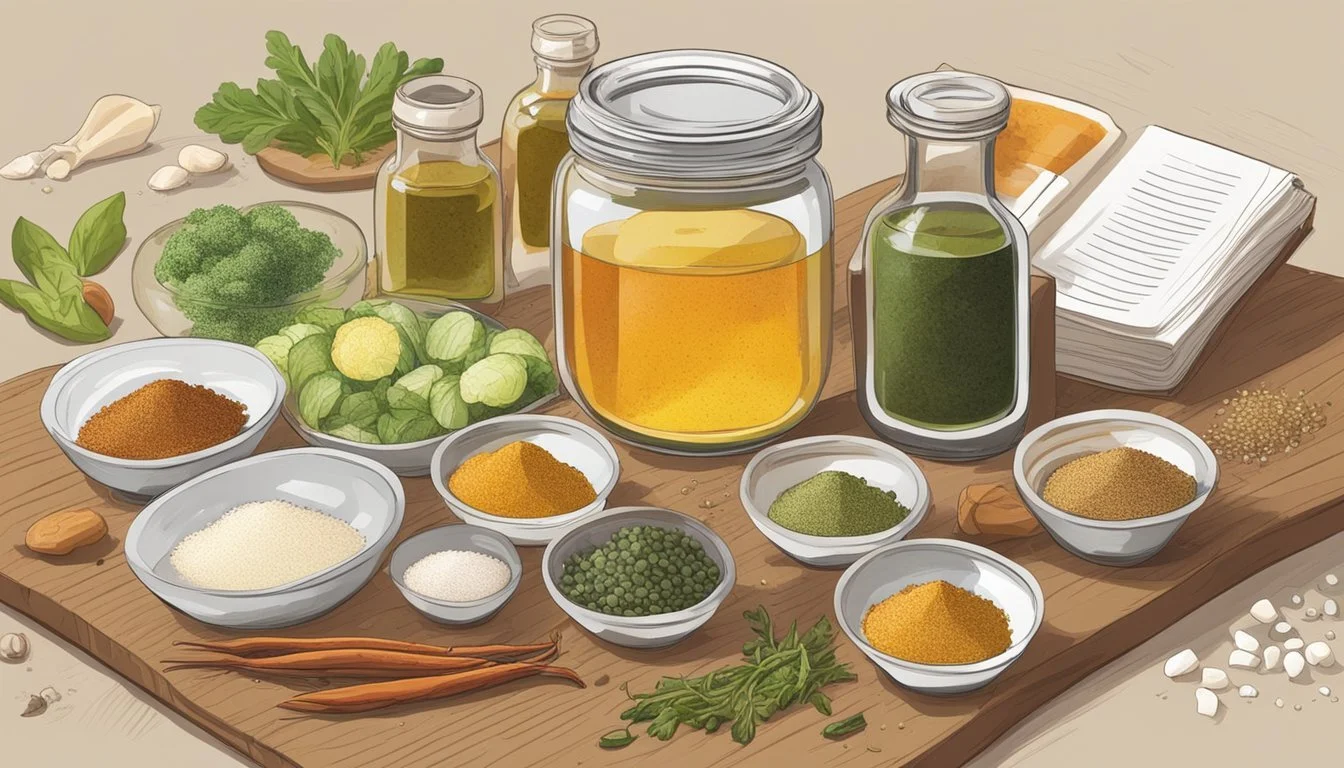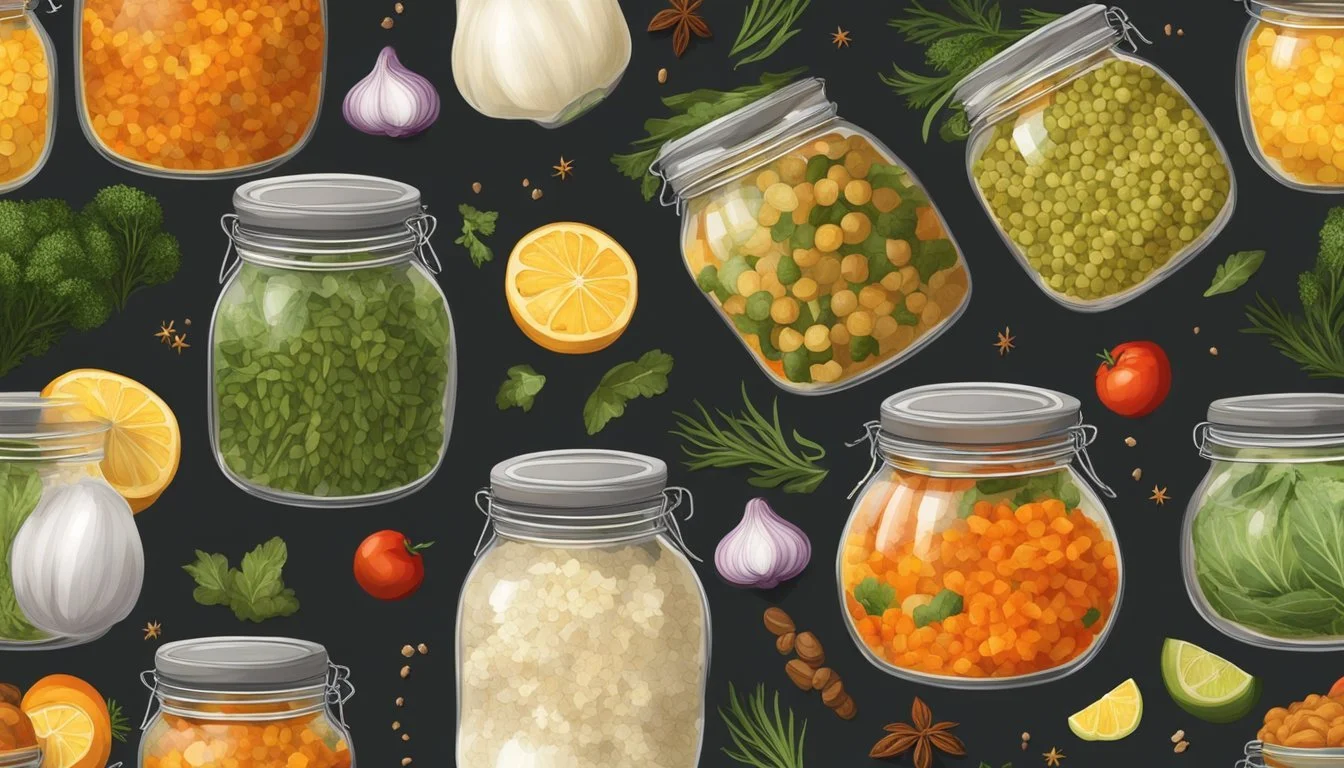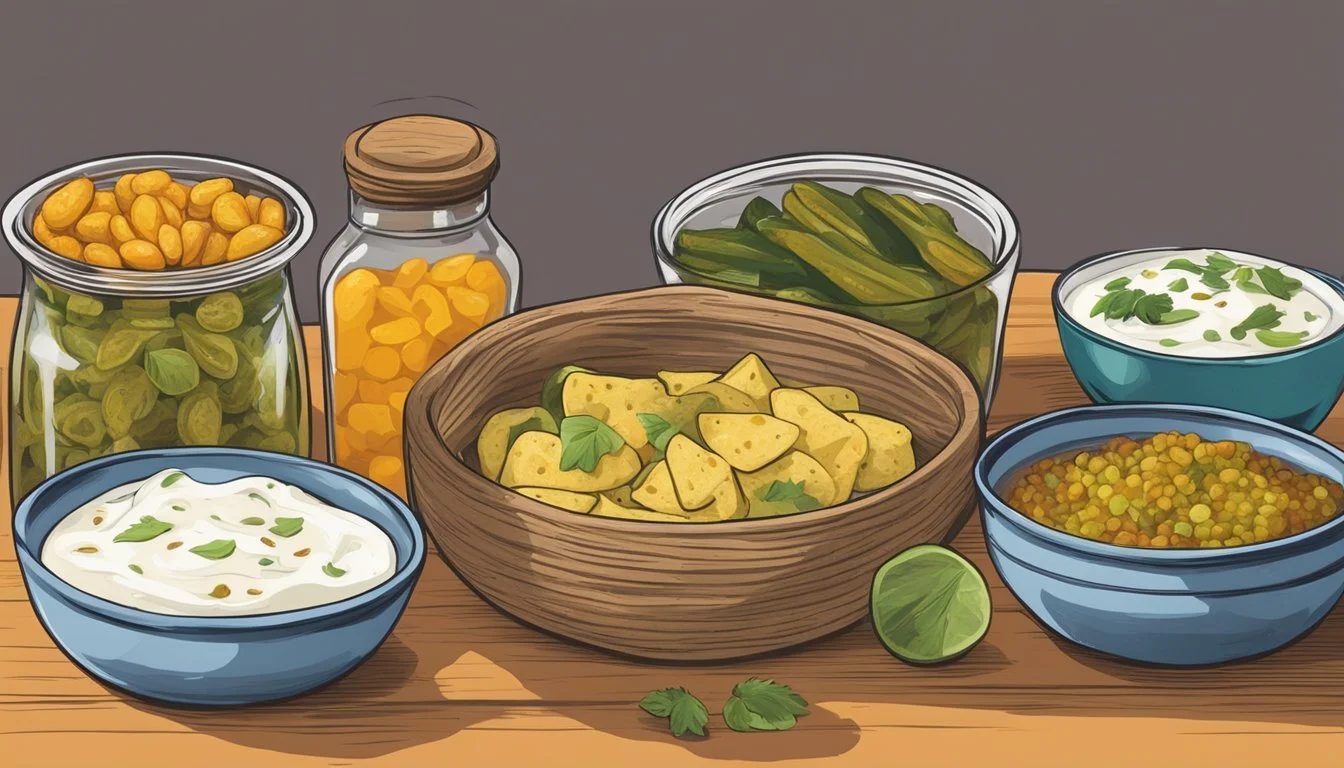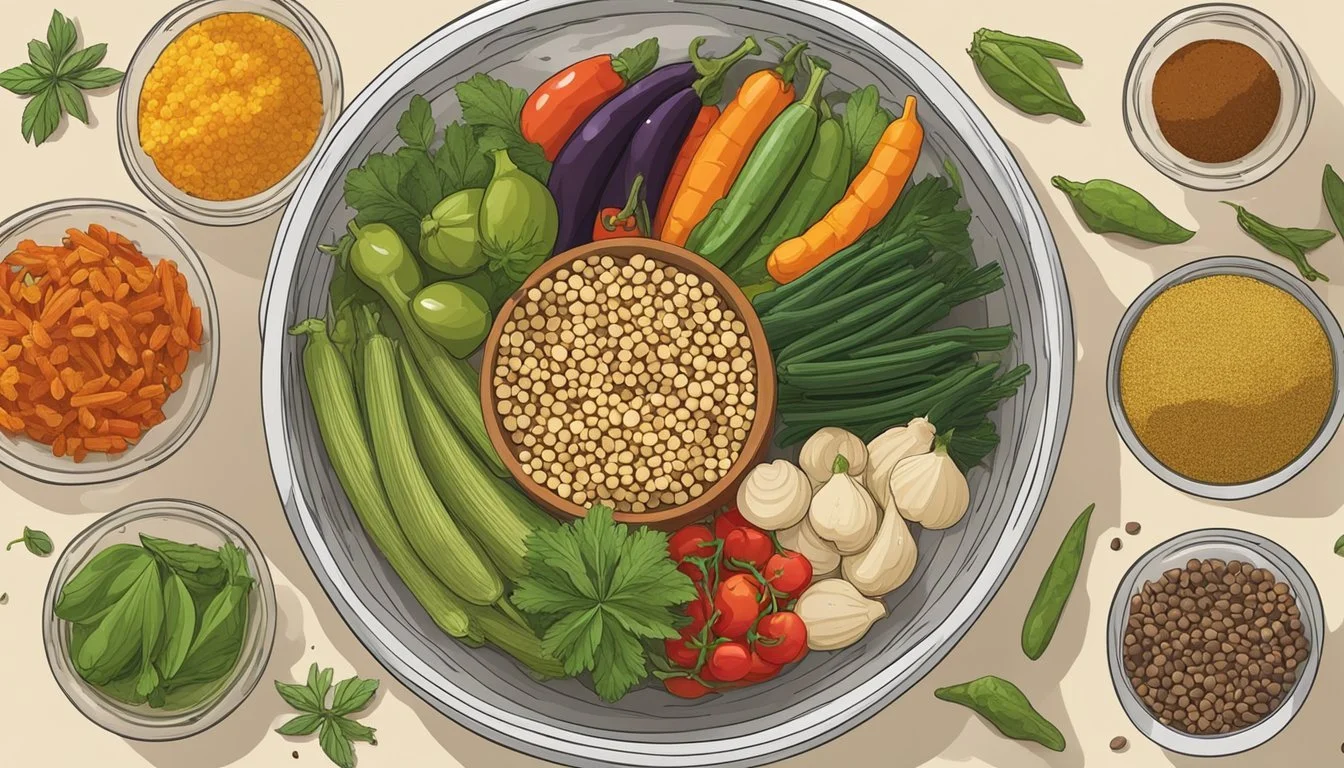How to Ferment Achar
Mastering South Asian Pickle Techniques
Fermentation is a time-honored method that not only preserves foods but also enhances their nutritional value and flavor characteristics. Achar, a traditional South Asian pickle, is a fine example of this technique, often made with an array of vegetables and fruits like mangoes, limes, and carrots. Rich in spices and typically bathed in oils and brines, achar undergoes a transformation through fermentation that results in a condiment that's both spicy and tangy, with complex flavors that develop over time.
The process of fermenting achar capitalizes on the warm climates typically found across South Asia, providing the ideal conditions for beneficial bacteria to thrive. The warm temperatures facilitate a faster fermentation process as compared to cooler climates where fermenting might take longer or might not occur to the same extent. As the mixture sits, whether in the sun or indoors, the ingredients marinate and the natural sugars break down, allowing the flavors to meld and deepen.
Creating achar at home involves attention to detail and cleanliness to ensure a safe and successful fermentation. From the selection of quality ingredients to the meticulous sterilization of jars, the preparation sets the stage for the unique and delicious end product. Balancing spices like fenugreek, mustard seeds, and turmeric with the right amount of salt and oil not only contributes to the distinctive taste but also plays a crucial role in the preservation process. The result is a robust condiment that can elevate any meal by providing a burst of intense flavor.
Understanding Achar: The Basics
Achar, the South Asian pickle, is a traditional condiment deeply rooted in the culinary practices of countries like India, Pakistan, Singapore, and Malaysia. It is a flavorful accompaniment to main dishes, known for its tanginess and variety.
Historical Significance
The tradition of making achar can be traced back centuries in South Asian cultures. This preservation technique was vital for extending the shelf life of foods, especially in times when refrigeration was not available. In the diverse regions of India and Pakistan, achar became more than just a method of preservation; it evolved into a culinary art, with recipes passed down through generations. Each household often holds its own secret blend of spices, creating a unique flavor profile that is a source of pride.
Varieties Across South Asia
Achar boasts a wide range of flavors and ingredients across South Asia:
India: Known for its diverse regional varieties, Indian achar ranges from Mango (most popular) to lemon, chilli, and mixed vegetables, all spiced with fenugreek, mustard seeds, and turmeric.
Pakistan: Pakistani achar often includes green chillies or mixed vegetables with a focus on mustard oil and a blend of spices offering bold flavors.
Singapore and Malaysia: These countries have integrated achar into their local cuisine, with Nonya Achar being a variant that includes vegetables like cucumbers and carrots in a vinegar-based pickle.
The achar-making process typically involves drying the chosen produce, mixing it with a blend of spices and oil, and allowing it to ferment, which develops its complex flavor profile.
Essential Ingredients & Their Roles
The process of fermenting achar is precise and calls for specific ingredients, each serving a unique purpose. The crafting of South Asian pickles hinges on the interplay between the main ingredients, spices that imbue distinctive flavors, and the preservatives that ensure longevity.
Main Ingredients
Vegetables and fruits serve as the base for achar. Common choices include mango, lime, and various vegetables such as carrots and cucumbers. These provide texture and the primary flavors.
Vegetables/Fruits:
Mango
Lime
Carrots
Cucumbers
Spices & Flavorings
The character of achar comes from its spices and flavorings. Robust mustard seeds, pungent fenugreek seeds, and aromatic asafoetida (hing) are traditional spices that deliver the quintessential South Asian aroma and taste. Turmeric adds color and health benefits, while garlic and ginger offer depth with their earthy tones. Chilli powder heats up the palate, completing the complex flavor profile of achar.
Spices:
Mustard seeds
Fenugreek seeds
Asafoetida (hing)
Turmeric
Garlic
Ginger
Chilli powder
Preservation Agents
The longevity of achar is guaranteed by preservation agents like salt, vinegar, and oil. Salt not only flavors but also inhibits unwanted bacterial growth. Vinegar, with its acidity, acts as a preservative and brings tanginess. Mustard oil is often the oil of choice, heralded for its preservative qualities as well as its pungent aroma which is crucial to many achar recipes.
Preservation Agents:
Salt
Vinegar
Mustard oil
Each ingredient in the achar-making process brings an indispensable property to foster the fermentation, provide rich taste, and ensure preservation.
Equipment and Preparation
To ensure success in fermenting achar, one must begin with the right tools and properly prepared ingredients. This foundational step is crucial for both safety and flavor.
Selecting the Right Equipment
For fermenting achar, the essentials include:
Glass Jars: Strong, clean, and with airtight lids to prevent contamination. Jars should preferably be of a size that matches the batch of achar being prepared – generally, 12-ounce jars work well.
Cutting Tools: Sharp knives for slicing vegetables and fruits efficiently.
Cutting Board: To ensure a clean workspace.
Measuring Equipment: Spoons and cups for precise brine preparation.
The equipment should be sterilized before use to maintain hygiene and to ensure the achar ferments properly without any harmful bacteria.
Preparing Vegetables and Fruits
Preparation of the produce is just as important as the equipment. Here's a step-by-step guide:
Washing: Thoroughly clean vegetables and fruits like cucumbers, carrots, mangoes, cauliflower, cabbage, lotus root, and onions to remove any dirt or debris.
Peeling and Cutting: Peel items like mangoes and carrots. Chop into uniform sizes for an even ferment.
Drying: Pat the vegetables and fruits dry to prevent excess moisture from diluting the brine.
Salting: Sprinkle salt over the cut vegetables and fruits, then set them aside to let the salt draw out water, which helps in the fermentation process.
Adherence to these preparation methods lays a strong foundation for a flavorful and safe fermentation process.
Preparing the Achar Mixture
When preparing an Achar mixture, meticulous attention to mixing techniques and the quality of spices and ingredients is essential to achieve the desirable tangy, spicy, or sweet flavor profile typical of this South Asian delicacy.
Mixing Techniques
For an Achar recipe, proper mixing ensures the even distribution of flavors. Begin by sterilizing all mixing bowls and utensils to prevent contamination. In a large, non-reactive bowl, combine the pre-cut vegetables such as cucumbers, carrots, and cauliflower. It's crucial that these vegetables are dry to prevent diluting the spices. Mix gently yet thoroughly to avoid damaging the vegetables, which may be done using clean, dry hands or a utensil.
Combining Spices and Ingredients
The spices are the soul of any Achar. The ideal blend often includes mustard seeds, fenugreek seeds, fennel seeds, and nigella seeds. Toasting these spices slightly before crushing them can intensify their flavors. For a tangy Achar, lemon juice is a staple, while for a sweeter variety, a hint of sugar or jaggery can be incorporated. Olive oil or sesame oil can be used to form a paste with the spices before mixing them into the vegetables. Lastly, sesame seeds may be sprinkled on top for added texture. Use the following list as a guide to proportions:
Vegetables: As required (pre-cut, dry)
Toasted spices mixture: 1-2 tablespoons
Lemon juice or vinegar: 2-3 tablespoons (for tanginess)
Olive oil: 1-2 tablespoons (for paste)
Sesame seeds: 1 tablespoon (optional, for texture)
Incorporate these ingredients evenly, making sure the spices coat all the pieces. The mixture should be flavorful but not overpowering. Once mixed, the Achar can be set aside to marinate or can immediately proceed to the fermentation process.
Fermentation Process
The fermentation of Achar hinges on the cultivation of beneficial bacteria in a controlled environment over a period which can range from several weeks to months.
Fermentation Science
Fermentation is a metabolic process that converts sugar to acids, gases, or alcohol. It occurs in yeast and bacteria, but for Achar, lactic acid bacteria are the main agents of fermentation. They thrive in an anaerobic (oxygen-free) environment, which is created when the Achar is submerged in water or brine. The salt in the brine inhibits the growth of harmful bacteria, ensuring that only the desired bacteria flourish. Over time, these bacteria produce lactic acid, which lowers the pH of the mixture and preserves the South Asian pickle.
Primary Agents: Lactic acid bacteria
Environment: Anaerobic, salty
Outcome: Acidified and preserved Achar
Monitoring Fermentation Phases
Monitoring the process of fermentation ensures the safety and desired flavor profile of the Achar. In the initial stages, one must make sure the vegetables are fully submerged to prevent unwanted microbial activity. As the weeks progress, the Achar will start to sour due to the production of lactic acid. The appearance, taste, and smell are good indicators of the fermentation progress, but for precision, one could measure the pH level. The goal is to reach a pH of 4.6 or lower, which is safe for storage and indicated successful preservation.
Initial Stage: Submerge in brine, prevent contamination
Indicators of Progress: Souring taste, change in smell
pH Goal: 4.6 or lower for safe storage
Storing and Maturing Achar
Once preparation is complete, storing and maturing are crucial steps for Achar. They ensure the development of flavor and preservation.
Optimal Storage Conditions
Achar thrives in a cool, dark environment. Ideally, it should be stored in glass jars to prevent reactions with the condiment's acidity. The refrigerator is an excellent storage location as it maintains a consistent temperature that slows down fermentation and helps prevent spoilage. The jars should be sealed tightly to prevent contamination and to keep the Achar immersed in its brine or oil, which acts as a preservative. Here’s how to ensure optimal storage:
Container: Use clean, airtight glass jars.
Temperature: Keep the jars in a refrigerator at or below 4°C (39°F).
Light: Store in a dark place to prevent light-induced changes.
Seal: Verify that the seal is tight to keep out harmful bacteria.
Maturation Timelines
Achar's flavor matures and evolves over time. The maturation process typically spans weeks to months, during which the Achar develops its characteristically bold taste. To track the maturation process, one may consider the following timelines:
Initial Maturation: A minimum of one week in the refrigerator will allow flavors to meld.
Peak Maturation: Depending on the ingredients and recipe, Achar can take several weeks to several months to fully mature.
The exact timing will vary based on the specific type of Achar and personal taste preferences. Regular tastings can guide one on when the Achar has reached the desired flavor profile. Once it reaches this stage, it can be consumed or kept stored, as the flavors will continue to evolve, though more slowly.
Serving and Pairing Suggestions
Achar, a vibrant condiment, enhances meals with its bold flavors. It traditionally complements Indian dishes and can be creatively paired with various cuisines to add a flavorful twist.
Traditional Combinations
In Indian cuisine, Achar is a staple that pairs exquisitely with rice and dal—lending a spicy tang to these everyday staples. It also serves as an accompaniment to curries, providing a burst of flavor that balances out the rich gravies. The pickle is often served alongside nan, adding complexity to the soft bread. A spoonful of Achar mixed with yogurt can produce a quick, spicy raita that acts as a cooling side dish.
Modern Fusion Ideas
Culinary enthusiasts often share their fusion Achar pairings on Instagram, showcasing innovative uses. Achar can transform a plain sandwich into a delightful meal with its tangy zest. It pairs well with eggs, giving an ordinary breakfast an extraordinary twist. When added to salads, it brings an unexpected spike of flavor, elevating the taste profile. Furthermore, integrating Achar with meat marination imparts depth and a spicy kick that is both surprising and satisfying to the palate.
Health Benefits and Considerations
When considering the health benefits and considerations of Achar (South Asian pickles), one must look at both the nutritional value and any dietary adjustments that accompany its consumption.
Nutritional Value
Achar, a fermented condiment, often includes a variety of vegetables like carrot, cucumber, ginger, and garlic. These ingredients contribute to the overall nutritional profile of Achar. The fermentation process not only preserves these vegetables but also enhances their bioavailability of nutrients. The presence of antioxidants such as flavonoids and phenols in Achar help combat inflammation and protect against oxidative stress. Vitamin-rich carrot and cucumber are supplemented with ginger and garlic, which have been known for their medicinal properties.
Carrot and Cucumber: Good sources of fiber and vitamins.
Ginger: Contains gingerol, known for anti-inflammatory and antioxidant properties.
Garlic: Offers allicin, which has been attributed to reducing blood pressure and cholesterol.
Dietary Adjustments
Consumers should be aware that while Achar provides health benefits, it is generally high in salt, which is integral to the fermentation and preservation process. Individuals with hypertension or those watching their sodium intake should consume it in moderation. Moreover, the fermented pickles serve as probiotics, which can promote a healthy gut microbiome. Regular inclusion of Achar in one's diet should be balanced with other low-sodium options to maintain a healthy diet.
Probiotics: Support a healthy digestive system.
Sodium: Monitor intake to avoid potential health risks.
In summary, Achar offers a range of health benefits due to its fermented nature and the nutrient-rich vegetables it contains. However, one must balance its consumption with attention to sodium content for an overall healthy diet.
Variations and Innovations
Achar, or South Asian pickles, demonstrate a rich tapestry of tastes and textures, influenced by regional ingredients and cultural preferences. They range from spicy to sweet, sour to savory, and are an integral part of meals, providing a burst of flavor.
Regional Variations
The terroir of South Asia brings forth an assortment of achars—each region adding its unique stamp:
North India: Often features spicy and aromatic pickles with mustard oil, where mango and lemon are prevalent.
South India: Known for hot and sour variations using tamarind and green chillies. Lime and cucumber are also popular.
East India: Sweets and desserts sometimes accompany sweet and sour achars, where fruits like dates are commonly pickled.
West India: Here, chutney-like pickles using fenugreek and mustard seeds are a staple.
These regional variations showcase the diversity, transforming simple meals into an array of complex flavors.
Creative Additions
Innovations in pickling have led to exciting new flavors that transcend traditional boundaries:
Fruit and Vegetable Fusion: Combining unconventional fruits and vegetables, such as kiwi or carrots, can result in a delightful mix of flavors.
Use in Dishes: Achars are being incorporated into dishes like sandwiches, adding a tangy twist to international cuisine.
Sweet Spins: Some modern achars lean towards the sweeter side, acting as a counterpoint to spicy dishes (What wine goes well with spicy dishes?) or even as a unique dessert component.
By embracing these variations and creative additions, achar remains a beloved and continually evolving element of South Asian gastronomy.
Troubleshooting Common Issues
When fermenting achar, a South Asian pickle, individuals may encounter issues with texture or flavor. The following subsections offer straightforward solutions to these common problems, ensuring that the achar remains flavorful, tangy, and enjoyable.
Texture Problems
Mango achar, a popular variety, should have a firm texture, but it can sometimes become too soft or mushy. This is often due to over-fermentation or exposure to excess moisture. They can check the texture by gently pressing a piece of the mango; it should yield slightly but not fall apart.
Problem: Mango becomes too soft.
Feedback: If the mango is softer than desired.
Solution: Ensure a proper salt concentration in the brine to maintain crispness. They should use a salt concentration of 2-5% by weight.
Problem: Mushiness setting in before fermentation is complete.
Solution: They might consider adding crunch-preserving additives like calcium chloride or cutting the mango into larger chunks.
Flavor Imbalances
Achar should taste boldly sour and tangy, but an imbalance in flavor can occur. This is often a result of incorrect proportions of spices, inadequate fermentation time, or contamination.
Problem: Achar is not sour enough.
Feedback: Limited tangy taste or lack of sour component.
Solution: They can allow the achar to ferment longer, carefully tasting it for increased sourness. It's essential to keep fermentation conditions constant and avoid excessive interference.
Problem: Achar is too salty or spicy.
Feedback: Overwhelmingly salty or heat from spices dominates.
Solution: They should ensure that the spices and salt are measured accurately according to the recipe. If a batch becomes too salty, they can try adding small amounts of sugar to balance the flavor or dilute with more vegetables.
Leveraging Social Media
In the world of Achar-making, social media platforms like Instagram offer a treasure trove of opportunities for sharing the fermentation process, gaining feedback, and connecting with a community of enthusiasts.
Sharing Your Achar Journey
When a home cook decides to share their Achar journey on Instagram, they invite an audience into the intricacies of their craft. Instagram stories and posts become a visual diary, documenting each step from selecting the perfect ingredients to the final product.
Posting Photos: Clear, high-quality images capture the vibrant colors and textures of Achar, enticing followers and drawing them into the experience.
Frequent Updates: Keeping followers engaged with regular updates can lead to a more invested audience that looks forward to each stage of the fermentation process.
Feedback Loop: As followers comment on posts, the cook gains valuable insights and tips that can refine their Achar-making skills.
Through sharing, a cook showcases their expertise while simultaneously building a network of fellow Achar aficionados. This exchange promotes knowledge and celebrates cultural traditions surrounding this beloved South Asian specialty.
Conclusion & Call to Action
Fermenting Achar is both an art and a science, allowing one to preserve the bounty of their garden or market in a flavourful and nutritious way. Those who have honed their pickling skills understand that the end result is not just a condiment but a lively, fermented food that enhances the meals it accompanies.
They should consider:
Providing Feedback: If one has tried the Achar recipe, they should feel encouraged to offer their insights. This feedback could help iterate and improve the process for everyone.
Engaging with the Community: Sharing discoveries and challenges with fellow fermenting enthusiasts can foster a supportive environment. Whether through online forums or local groups, this communication elevates the collective knowledge and expertise.
One ought to:
Share the Recipe: If one has found success with their Achar, they should consider sharing it. There is joy in spreading the flavors of one's heritage or creating new traditions.
Embrace Experimentation: They are reminded that there are no limits to the variations and flavors possible, so creativity is always encouraged.
In sharing their Achar and experiences, one contributes to a delicious tapestry of communal knowledge, ensuring these rich traditions continue to thrive. They should remember that each jar of Achar is more than just a pickle; it's a testament to cultural history and culinary innovation.
Provide Feedback: Improve and refine the Achar making process
Engage Communities: Learn and grow in the art of pickling
Share the Recipe: Spread the joy of homemade Achar
Embrace Experimentation: Discover new flavors and techniques
Readers are encouraged to embrace this journey of fermentation with confidence and curiosity, making each batch of Achar a unique and rewarding experience.






